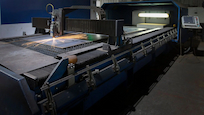How can CNC Punch Laser Combined Machine be applied to more factories?
Nov 07, 2025
1. Accurately convey core values and address the "pain points" of factories
When promoting, it is necessary to explain the direct economic benefits it can bring in a language that factory owners and production managers can understand.
"One machine replaces multiple lines", saving space and initial investment
Promotional point: There is no need to purchase separate punch presses and laser machines, reducing the floor space occupied by the equipment, power configuration and basic investment.
Tell the factory owner: "You only need one investment to establish a complete sheet metal processing unit, which is particularly suitable for new factories with limited factory space or those planning new production lines."
Minimize processes to the extreme to enhance efficiency and delivery time
The promotional point: It eliminates the process of transferring, re-clamping and secondary positioning between the punch press and the laser machine. The sheet is clamped once to complete all processing.
Tell the production manager: "The delivery time of your products can be shortened by 30% to 50%." Because there is no intermediate flow or waiting time, it is particularly suitable for small-batch and multi-variety urgent orders.
Break through design limitations and empower high value-added products
Promotional points: The mold-free nature of lasers enables them to easily cut any complex shapes and inner cavities. The high efficiency of stamping allows for rapid processing of louvers, bumps, threaded holes, etc.
Tell R&D/designers: "You can freely design complex products without being restricted by molds." Laser cutting creates elegant curves, and stamping instantly forms functional structures, making your products more unique and competitive in the market.
Reduce reliance on highly skilled operators
Promotional point: One device, one set of programming software (usually integrating stamping and laser functions), and one operator can complete the entire process from programming to production, reducing management and labor costs.
Second, innovate business models and lower application thresholds
The high initial investment is the main reason why many small and medium-sized factories are deterred. It needs to be resolved through a flexible business model.
Financial leasing and installment payments
Cooperate with financial institutions to offer flexible installment or lease plans for factories, converting huge capital expenditures into manageable monthly operating costs.
"Trade-in" program
Encourage factories with old single-function punch presses or laser machines to upgrade their equipment, use the old equipment to offset part of the purchase price, and accelerate equipment iteration.
Establish demonstration factories and experience centers
Establish demonstration sites in industrial zones to allow potential customers to witness the efficient operation of the equipment with their own eyes. They can also bring their own samples for on-site sampling and convince them with actual results.
Cooperate with the sheet metal industry chain
Cooperate with sheet material suppliers, spray painting factories, etc. to provide their customers with packaged solutions of "equipment + materials + post-treatment", increasing their appeal.
Third, promote technological popularization and enhance usability to remove usage obstacles
Make the factory feel that it is "user-friendly, daring to use and easy to use".
Develop more intelligent and integrated software
The software should be capable of automatically identifying the features of the drawings, intelligently recommending whether to use stamping or laser processing (for example, small round holes and holes of the same batch should be stamped, and complex contours should be processed with laser), and automatically generating the optimal processing path to reduce programming difficulty.
Provide strong technical training and support
We offer a full range of training from programming, operation to maintenance. Establish a rapid response local service team to provide 7x24-hour technical support and solve the factory's worries.
Modular and upgradable design
Provide the basic model and reserve the upgrade interface. Factories can first purchase configurations that meet current needs. In the future, based on business development, they can add automated modules such as automatic loading and unloading, sorting and palletizing to reduce initial investment.
Fourth, accurately identify the target industry and customer group
Not all factories are suitable for immediate purchase. It is necessary to find the right breakthrough point.
Core target customers
Sheet metal processing service center: They are the most ideal target users for composite machines because their business is to undertake various scattered and high-demand sheet metal parts.
Equipment manufacturers specializing in multi-variety and small-batch production: such as those in industries like chassis and cabinets, elevators, food machinery, medical devices, environmental protection equipment, and intelligent warehousing equipment.
Innovative enterprises in a period of rapid growth: They have high requirements for production flexibility and product iteration speed, and are willing to invest in advanced equipment to build core advantages.
Potential market
Replacement market: The target is those factories that are still using old-fashioned single-function equipment and have encountered production efficiency bottlenecks. Use the high efficiency of multifunctional machines to convince them to carry out "production upgrades".
if you have more ideas, please contact us!
Tel: +86 -18855551088
Email: Info@Accurl.com
Whatsapp/Mobile: +86 -18855551088

